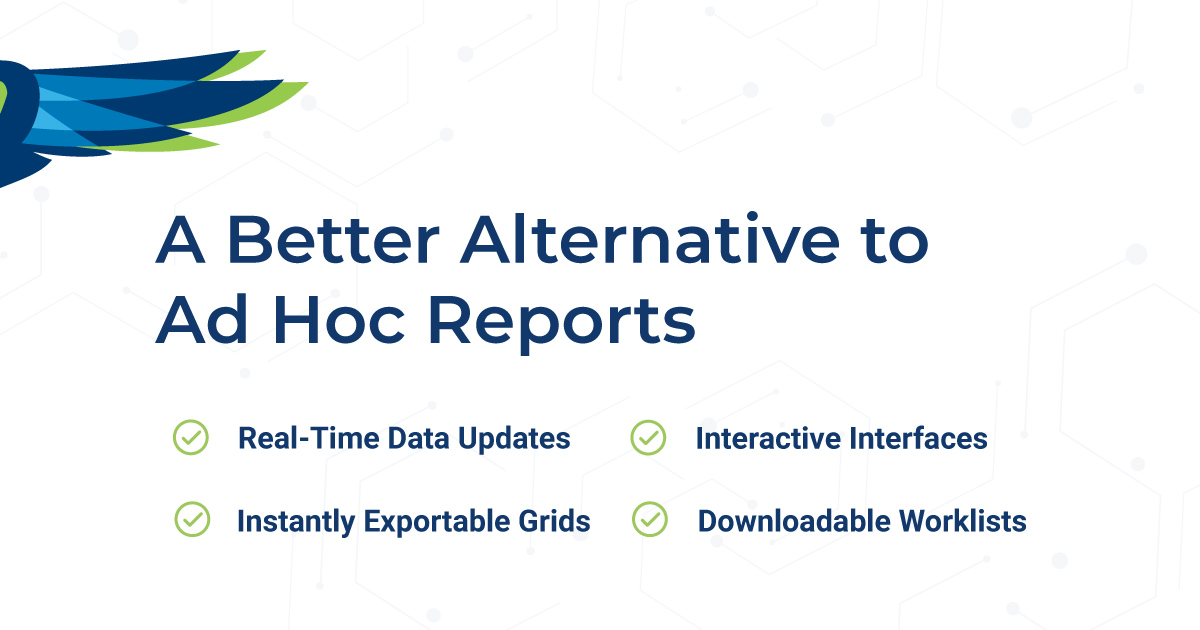IN THIS ARTICLE:
- What is ad hoc reporting in DME billing?
- What are dynamic data grids?
- How data grids can revolutionize reporting
Ad Hoc Reports and Your DME Billing Practice
Ad hoc reports have been a staple of DME billing for decades, mostly as a result of necessity. This functionality allows users to generate reports in response to specific queries using preset data fields. For as long as these reports have been used, their format has changed fairly little. As businesses evolve, however, so too must the tools of the trade.
If your billing team has ever been frustrated by the limitations or inefficiencies of ad hoc reporting, there’s good news — there’s finally a smarter way to do things. TrueSight was designed by billing professionals like yourself to rethink the practice of DME billing with simpler, more effective, more intuitive tools. Enter dynamic data grids, TrueSight’s answer to outdated reporting methods. Here’s everything you need to know.
Understanding Ad Hoc Reporting
What It Is and How It Works
Though ad hoc reports need no introduction for the seasoned professional, it pays to understand where we came from. These reports rely on preset data fields and are commonly used in various business scenarios, including areas like inventory management, revenue tracking, patient lists, and more. While there is a level of customization, there are some significant drawbacks to this long-used method.
The Limitations of Ad Hoc Reporting
If you’ve ever put in the work to produce one, you don’t need us to remind you that ad hoc reports can be painfully time-consuming. Likewise, they’re inefficient in terms of navigation, requiring users to deviate from the established workflow just to find the data they need. The process lacks both consistency and standardization across platforms, making it all the more difficult to ensure accuracy.
At the same time, the preset fields can be confusing, indirect, or simply not optimized for the questions you’re trying to answer, leading to unnecessary guesswork and more potential inaccuracies. And, perhaps more concerning, ad hoc reports lack real-time updates, calling into question the veracity of the information produced.
If you’re thinking there has to be a better way, the team at TrueSight agrees wholeheartedly. Here’s what we can do about it:
Dynamic Data Grids: The Reporting Tool of the Future
What Are Dynamic Data Grids?
Dynamic data grids are TrueSight’s answer to the outdated practice of ad hoc reporting, offering instead a user-friendly and efficient approach to data analysis. In TrueSight’s software, these grids are equipped with filters, favorite markers, and the ability to export data directly into Excel. Best of all, these grids are dynamic, providing real-time updates to ensure the data you’re accessing is accurate.
How Data Grids Revolutionize Reporting
There are a few essential features that make data grids the reporting tool of the future — and a welcome replacement for ad hoc reports. Here are some highlights:
Real-Time Data Updates — TrueSight’s data grids are continually updated as data changes, ensuring the information you rely on is timely and trustworthy.
Interactive Interfaces — TrueSight was designed for intuitive and user-friendly navigation. Data grids allow users to find and manipulate data effortlessly from their usual workflow.
Instantly Exportable Grids — Now, users can directly export the information they need, eliminating the guesswork of which data is included in which report.
Downloadable Worklists — TrueSight users can download data grids as worklists directly, allowing for the easy assignment of tasks with minimal disruption.
How Dynamic Data Grids Outperform Ad Hoc Reports
Real-Time Data Access
Perhaps the most game-changing advantage of dynamic data grids is the real-time access to data they can offer. These grids are living lists, continually updated with new information so you never have to wait or guess. This capacity is critical for DME billing, where timely decisions can make a big difference in the revenue cycle and bottom line.
Scalability and Flexibility
Finally, data grids are a remarkably scalable tool, allowing DMEs to navigate large datasets without confusion, regardless of the size of the business. For the up-and-coming billing team, this feature promises long-term possibilities; as your business grows and adapts, your software — and its data grids — will adapt with you.
Try Out Dynamic Data Grids With TrueSight Today
Dynamic data grids offer innumerable benefits over ad hoc reporting and virtually all traditional methods of data analysis. Instead of navigating complex data by hand without even the assurance of its accuracy, invest in software that updates and organizes on your behalf, simplifying your work and producing faster, more accurate results.
If you’re ready to walk away from ad hoc reporting and empower your team with the tools it needs for a brighter future in DME billing, we’d like to welcome you to TrueSight. With a free, personalized demo, you too can discover the difference that dynamic data grids for your data can make.
Ready to take the leap? Contact TrueSight for your FREE DEMO today.






